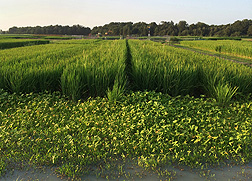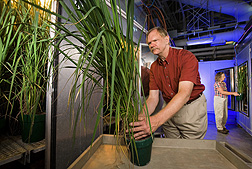Finding Rice Traits That Tackle Climate-Change Challenges
People around the world depend on food crops adapted to an array of temperature and precipitation regimes, but those conditions are in flux because of global climate change. So scientists want to identify plant traits that could be used to develop food-crop cultivars that thrive despite—or perhaps because of—shifts in carbon dioxide (CO2) levels, water availability, and air temperature.
As part of this effort, Agricultural Research Service plant physiologists Lewis Ziska, Martha Tomecek, and David Gealy conducted a study of several rice cultivars to determine whether changes of temperature and CO2 levels affected seed yields. They also looked for visible traits that could signal whether a plant cultivar has the genetic potential for adapting successfully to elevated CO2 levels.
For their study, the scientists included weedy red rice, which infests cultivated rice cropland. Despite the plant’s downside, previous assessments indicated that weedy rice growing under elevated CO2 levels had higher seed yields than cultivated rice growing under the same conditions.
The scientists used environmental growth chambers to study genetically diverse rice cultivars at current and future projections of atmospheric CO2 and a range of day/night air temperatures. They observed that on average, all the rice cultivars put out more aboveground biomass at elevated CO2 levels, although this response diminished as air temperatures rose.
For seed yield, only weedy rice and the rice cultivar Rondo responded to elevated CO2 levels when grown at optimal day/night air temperatures of 84 °F and 70 °F. The researchers were also intrigued by an additional observation: Only weedy rice gained significant increases of aboveground biomass and seed yield under elevated CO2 levels at the higher temperatures expected for rice-growing regions by the middle of the century.
When Ziska and colleagues analyzed the study data for the weedy rice, they observed that seed-yield increases under elevated CO2 resulted from an increase in panicle (seed head) and tiller production. Tillers are stalks put out by a growing rice plant, and as the plant matures, the seed heads—where rice grain is produced—develop at the end of the tillers.
Since rice tiller production is determined in part by a plant’s genetic makeup, crop breeders might someday be able to use this weedy rice trait to develop commercial rice cultivars that can convert rising CO2 levels into higher seed yields. To the researchers, these findings also suggest that the weedy, feral cousins of cultivated cereals could have other traits that would be useful in adapting to the environmental challenges that may come with climate change.
“We know that atmospheric CO2 and air temperatures will increase together,” says Ziska. “Ideally, we can develop plants that respond well to elevated CO2 levels and incorporate traits that favor plant survival despite temperature changes.”
Ziska and Tomecek are with the ARS Crop Systems and Global Change Laboratory in Beltsville, Maryland, and David Gealy is with the ARS Dale Bumpers National Rice Research Center in Stuttgart, Arkansas. The researchers published their findings in 2013 in Functional Plant Biology.—By Ann Perry, formerly with ARS.
This research is part of Climate Change, Soils, and Emissions, an ARS national program (#212) described at www.nps.ars.usda.gov.
To reach the scientists mentioned in this story, contact Ann Perry, USDA-ARS Information Staff, 5601 Sunnyside Ave., Beltsville MD 20705-5128; (301) 504-1628.
"Finding Rice Traits That Tackle Climate-Change Challenges" was published in the November/December 2014 issue of Agricultural Research magazine.








